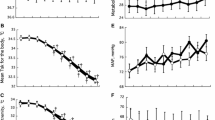Summary
In 28 subjects the cardiovascular response to repeated stimulation was monitored during six daily sessions. Calf blood flow was measured with mercury-in-silastic venous occlusion plethysmography, blood pressure with electronic sphygmomanometer. The stimuli used were: 1 kHz sound of 90 dB and 100 dB intensity and immersion of one foot for 60 s in water at 4° C. Initially sounds induced large vasodilatation in the calf, immersion of one foot in the water induced in the contralateral calf vasodilatation in one group and vasoconstriction in another group of subjects. The blood pressure changes were less prominent and less consistent. After the first session of repeated stimulation the vascular response during the second session was significantly diminished. The reduction of the vasodilatation was the most rapid. During the remaining 5 days the responses were suppressed. It has been established that in the patients in the initial stage of hypertension the ability to habituate vascular response is impaired (Zbrożyna and Krebbel 1985). It is therefore suggested that the test of the ability for long-term vascular habituation could be used as a supplementary diagnostic test.
Similar content being viewed by others
References
Abrahams VC, Hilton SM, Zbrożyna AW (1960) Active muscle vasodilatation produced by stimulation of the brain stem: its significance in the defence reaction. J Physiol 154:491–513
Abrahams VC, Hilton SM, Zbrożyna AW (1964) The role of active muscle vasodilatations in the alerting stage of the defence reaction. J Physiol 171:189–202
Blair DA, Glover WE, Greenfield ADM, Roddie IC (1959) Excitation of cholinergic vasodilator nerves to human skeletal muscles during emotional stress. J Physiol (Lond) 148:633–647
Brierley H (1969) The habituation of forearm blood flow on phobic subjects. J Neurol Neurosurg Psychiat 32:15
Brod J (1963) Haemodynamic basis of acute reactions and hypertension. Br Heart J 25:227–245
Caraffa-Braga E, Granata L, Pinotti O (1973) Changes in blood-flow distribution during acute emotional stress in dogs. Pflügers Arch 339:203–216
Clarke RSJ, Jean Gilsbury, Hellon RF (1958) Use of the strain gauge plethysmograph in assessing the effect of certain drugs on the blood flow through the skin and muscle of the human forearm. J Physiol 140:318–326
Cohen MJ, Johnson HJ (1971) Effects of intensity and the signal value of stimuli on the orienting and defensive responses. J Exp Psychol 88:286–288
Davis RC, Buchwald AM, Frankmann RW (1955) Autonomic and muscular responses and their relation to simple stimuli. Psychol Monogr 69:1–71
Fenz WD (1975) Strategies for coping with stress. In: Saranson JG, Spielberger CD (eds) Stress and anxiety, vol 2. Wiley, New York, pp 305–336
Forsyth RP (1972) Sympathetic nervous system control of distribution of cardiac output in unanaesthetised monkeys. Fed Proc 31:1240–1244
Golenhofen K, Hildebrandt G (1957) Psychische Einflüsse auf die Muskel-Durchblutung. Pflügers Arch 263:637
Kelly DHW, Walter CJS (1968) The relationship between clinical diagnosis and anxiety, assessed by forearm blood flow and other measurements. Br J Psychiat 114:611–626
Longhurst J, Capone RJ, Mason DT, Zelis R (1974) Comparison of blood flow measured by plethysmograph and flow-meter during steady state forearm exercise. Circulation 49:335–540
Mancia G, Baccelli G, Zanchetti A (1972) Haemodynamic responses to different emotional stimuli in the cat: patterns and mechanisms. Am J Physiol 223:925–933
Martin J, Sutherland CJ, Zbrożyna AW (1976) Habituation and conditioning of the defence reactions and their cardiovascular components in cats and dogs. Pflügers Arch 365:37–47
Petrinovich L (1984) A two-factor dual-process theory of habituation and sensitization. In: Peeke HVS, Petrinovich L (eds) Habituation, sensitization and behaviour, pp 17–52
Scholander T (1960) Habituation of autonomic response elements under two conditions of alertness. Acta Physiol Scand 50:259–268
Seal JB, Zbrożyna AW (1978) Renal vasoconstriction and its habituation in the course of repeated auditory stimulation and naturally elicited defence reaction in dogs. J Physiol 280:56P
Smith HW (1940) Physiology of the renal circulation. Harvey lectures 1939–40, series 35. The Science Press Printing Company, Lancaster, Pennsylvania, pp 166–222
Thompson RF, Groves PM, Teyler TJ, Roemer RA (1973) A dual-process theory of habituation: theory and behaviour. In: Peeke HVS, Herz MJ (eds) Habituation, vol 1. Academic Press, New York, pp 239–269
Whitney RJ (1953) The measurement of volume changes in human limbs. J Physiol 121:1–27
Zbrożyna AW (1976) Renal vasoconstriction in naturally elicited fear and its habituation in baboons. Cardiovasc Res 10:295–300
Zbrożyna AW (1982) Habituation of cardiovascular responses to aversive stimulation and its significance for the development of essential hypertension. Contrib Nephrol 30:pp 78–81. Karger, Basel
Zbrożyna AW, Krebbel F (1985) Habituation of the cold pressor response in normo-and hypertensive human subjects. Eur J Appl Physiol 54:136–144
Author information
Authors and Affiliations
Rights and permissions
About this article
Cite this article
Zbrożyna, A.W., Westwood, D.M. Habituation of vasodilatation in the calf elicited by repeated sensory stimulation in man. Europ. J. Appl. Physiol. 58, 284–290 (1988). https://doi.org/10.1007/BF00417264
Accepted:
Issue Date:
DOI: https://doi.org/10.1007/BF00417264



